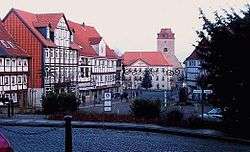Schöningen
| Schöningen | ||
|---|---|---|
|
Market place and St Vincent Church | ||
| ||
 Schöningen | ||
Location of Schöningen within Helmstedt district 
 | ||
| Coordinates: 52°08′N 10°57′E / 52.133°N 10.950°ECoordinates: 52°08′N 10°57′E / 52.133°N 10.950°E | ||
| Country | Germany | |
| State | Lower Saxony | |
| District | Helmstedt | |
| First mentioned | 747 | |
| Government | ||
| • Mayor | Henry Bäsecke (Ind.) | |
| Area | ||
| • Total | 35.36 km2 (13.65 sq mi) | |
| Population (2015-12-31)[1] | ||
| • Total | 11,430 | |
| • Density | 320/km2 (840/sq mi) | |
| Time zone | CET/CEST (UTC+1/+2) | |
| Postal codes | 38364 | |
| Dialling codes | 05352 | |
| Vehicle registration | HE | |
| Website | www.schoeningen.de | |
Schöningen is a town of about 11,000 inhabitants in the district of Helmstedt, in Lower Saxony, Germany.
Geography

The town is located on the southeastern rim of the Elm hill range, near the border with the state of Saxony-Anhalt. In its current form, it was created in 1974 by joining the municipalities of Esbeck, Hoiersdorf, and Schöningen.
Schöningen station was served by regional trains on the Wolfenbüttel–Helmstedt railway line until it was closed in 2007. The town is a stop on the scenic German Timber-Frame Road.
History
In archaeology, Schöningen is famous for the Schöningen Spears, four ancient wooden spears found in an opencast mine near the town (Bamford & Henderson 2003). The spears are about 400,000 years old (Klein. 2005. p114), making them the world's oldest human-made wooden artifacts, as well as the oldest weapons, ever found. Three of them were probably manufactured as projectile weapons, because the weight and tapered point is at the front of the spear making it fly straight in flight, similar to the design of a modern javelin. The fourth spear is shorter with points at both ends and is thought to be a thrusting spear or a throwing stick (Bamford & Henderson 2003). They were found in combination with the remains of about 20 wild horses, whose bones contain numerous butchery marks, including one pelvis that still had a spear sticking out of it. This is considered proof that early humans were active hunters with specialized tool kits. The spears are currently on display at the paläon visitor centre, opened in 2013.
The first historical mentioning of the Saxon settlement in the Royal Frankish Annals dates back to 747, when the Carolingian Mayor of the Palace Pepin the Short stayed at Scahaningi during the conflict with his half-brother Grifo. Schöningen was the site of a Königspfalz of Pepin's son Charlemagne and later of the Ottonian dynasty. Saint Willigis, Archbishop of Mainz from 975, was probably born at Schöningen about 940. He served as archchancellor of Emperor Otto III who stayed here several times. Schöningen was the site of a Benedictine abbey founded in 983. Nearby Elm Castle, erected in the 11th century, was the seat of a commandry of the Teutonic Knights from 1221 onwards.

From the 14th century it was held by the Welf dukes of Brunswick-Lüneburg, who granted Schöningen town privileges in 1332. About 1350 Duke Magnus the Pious had Schöningen Castle built as a hunting lodge and also to secure the nearby border with the Bishopric of Halberstadt. It was damaged during the Schmalkaldic War in 1542, when Duke Henry V of Brunswick-Wolfenbüttel fought against the troops of the Protestant Schmalkaldic League. It later served as a widow's seat of his consort Sophia Jagiellon, sister of the Polish king Sigismund II Augustus, and of her successors Elizabeth of Denmark and Anna Sophia, daughter of Elector John Sigismund of Brandenburg. Duchess Elizabeth, sister of King Christian IV of Denmark had the palace rebuilt in a lavish Renaissance style from 1613 onwards. In 1640 Anna Sophia established a Latin school (Anna-Sophianeum) in Schöningen, which exists as a Gymnasium up to today.
Schöningen Castle was also the administrative seat of a Brunswick Amtmann. From 1679 it served as the residence of Anna Sophia, daughter of Duke Anthony Ulrich of Brunswick-Wolfenbüttel and spouse of Margrave Charles Gustav of Baden-Durlach. Her sister Elizabeth Eleonora married Duke Bernhard I of Saxe-Meiningen here. In 1733 Prince Frederick II of Prussia stayed here en route to his marriage with Elisabeth Christine of Brunswick-Wolfenbüttel-Bevern at Salzdahlum. After the seat of the local administration was moved to Helmstedt in 1815, the castle decayed.
Economy
The main industry in Schöningen is open-cast mining of lignite, which is used for electricity generation in the Buschhaus Power Station. Both mining and generation are operated by E.ON subdivisions. Buschhaus power station and open-cast mining will be closed down in 2017.[2] The Buschhaus plant now inhibits three lines of thermal waste treatment.
The Sachtleben Chemie company was founded as Lithopone- und Permanentweißfabrik at Schöningen in 1878; the production facilities were relocated to Duisburg in 1892.
Schöningen is the site of a ground station operated by the German Federal Intelligence Service (Bundesnachrichtendienst) intelligence agency.
Politics
Seats in the municipal assembly (Stadtrat) as of 2011 elections:
- Social Democratic Party of Germany (SPD): 17
- Christian Democratic Union (CDU): 9
- Free Voters: 2
- Alliance '90/The Greens: 2
International relations
Schöningen is twinned with:
 Beni Hassen, Monastir Governorate, Tunisia
Beni Hassen, Monastir Governorate, Tunisia Oschersleben, Germany
Oschersleben, Germany Outokumpu, Finland
Outokumpu, Finland Zolochiv, Ukraine
Zolochiv, Ukraine
References
- Bibliography
- Klein, R. "Hominin dispersals in the old world". In Scarre, C. The human past: World prehistory and the development of human societies. London: Thames & Hudson. ISBN 978-0-500-28531-2.
- Bamford, Marion K.; Henderson, Zoe L. (2003). "A reassessment of the wooden fragment from Florisbad, South Africa". Journal of Archaeological Science. 30 (6): 637–651. doi:10.1016/S0305-4403(02)00245-5.
- Notes
External links
| Wikimedia Commons has media related to Schöningen. |
![]() Schöningen travel guide from Wikivoyage
Schöningen travel guide from Wikivoyage
 "Schöningen". Encyclopædia Britannica. 24 (11th ed.). 1911.
"Schöningen". Encyclopædia Britannica. 24 (11th ed.). 1911.- Official site
- Schöningen Spears Project

